|
|
|
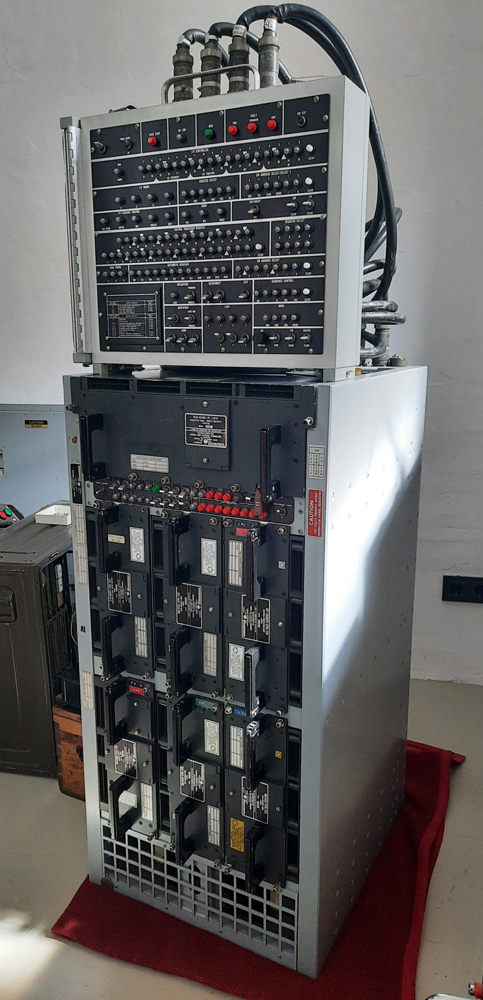
|
SPERRY
Univac AN/UYK-7 (V)
computer
set
Developed and designed 1968, based on
an announcement by the US Ministry of Defense/ NAVY to equip warships
with digital computers. Other applicants included IBM and Honeywell.
However, SPERRY UNIVAC won the framework contract.
The displayed unit was part of a German NAVY data center located in
Wilhelmshaven, Germany. Two of the seven moduls inside are marked with
"Rheinland Pfalz", which was a class F122 fregatte in the German Navy
(Bundesmarine) stationed in Wilhelmshaven.
The AN/UYK-7 ("Yuckseven") computer set became the standard Navy ship
computer. Because of the multi-processor capability it was used on all
types of ships and came in different configurations. Originally, the
chassis with serial A-1332 was part of a three-bay installation,
consisting of 2 CPUs, 2 I/O-Controllers and a memory bank.
The UYK-7 computer system was previously also installed on the German
class F103 warships (Lütjens-Klasse) at the Federal
German Navy.
It took me a while to reconfigure this unit to a standard one-bay
system. Three types of bus-systems - an instruction-bus, an
operand-bus, and an I/O-bus, each consisting of 52 signal-drilled lines
- have to be maintained and must be electronically terminated inside
the chassis. In addition, some signalling lines needed to be resolded
to say: there is now no other system besides you, and this is OK.
Each of the seven modules have its own terminal boards at the front
with up to 200 signal points for testing - a very comfortable selection
for troubleshooting. Furthermore, there is a maintenance console with
several bulbs and switches on top, designed in the classic black UNIVAC
manner to examine each step in a process and the status of the overall
82 CPU registers.
It is very interesting to see the many blinking lights during a simple
operation, for example the addition of two numbers; it costs attention
and focus to maintain an overview over the registers during the process
steps.
What seems very complicated is, however, internally a very fine and
well documented architecture. The arithmetic registers are with a few
exceptions implemented with NAND gates. UNIVAC had its own integrated
circuit design, and the contractors were MOTOROLA, FAIRCHILD, and
RAYTHEON. There is a good article written by Larry D. Bolton "The
UNIVAC 7901000-series Integrated Circuits" that covers this topic.
The UYK-7 has its own philosophy, oriented on the heavy I/O-traffic on
a warship for data collection, visualization and data calculation for
sonar, fire leading and target radar, display units and control of the
weapon systems. Therefore, the AN/UYK-7 has a very complex
IO-Controller with its own registers and its own comand set - the
I/O-bus has always the highest priority in all steps and operations.
Remarkable is the so called IO-adapter with 32 connectors, two each for
input and output. Input/Output is done with the NTDS (Naval Tactical
Data System), a very special and ornate protocol with tight
tolerances for pulse times, which cannot be compared with any interface
known in commercial environments.
Note the BATTLESHORT switch at the operator console.
It was intended to shorten an internal signalling system, which
normally shuts off the computer in case of overtemperatur or
overcurrent. When pressed, calculating still goes on.
I aquired and restored this unit with a few spares and a complet set of
original paper documentation in 2024.
See the full story below (in German language, because the museum is
located in Germany):
|
SPERRY
Univac AN/UYK-7 computer
set: front view with maintenance console on top, USA, St. Paul, ca.
1974.
|
Als echter Amerikaner und echter Schiffsrechner wird der AN/UYK-7
computer an
einem 3Ph-115V-400Hz Stromanschluss betrieben - eine auf dem (europäischen) Festland
nur schwerlich
zugängliche Art der Spannungsversorgung. Wie
schließt man einen solchen Rechner an und bringt ihn in
Betrieb?
Da im Netzteil sekundärseitig nur zwei Spannungen (-150V,
-38V) die Grundlage
für alle weiteren Schaltnetzteile in den Modulen bilden und
die 400 Hz Frequenz nicht taktgebend ist, war für dieses
Exemplar mit Ser. No. 1332 ein Umbau auf 1Ph-230V-50Hz
möglich; den Transformator hat die Firma Walcher gewickelt.
Betrieben mit entsprechenden Filtern und einer
Einschaltverzögerung zeigt der Rechner nach erfolgreicher Inbetriebnahme eine Gesamtleistung von
rund 3000 Watt.
|
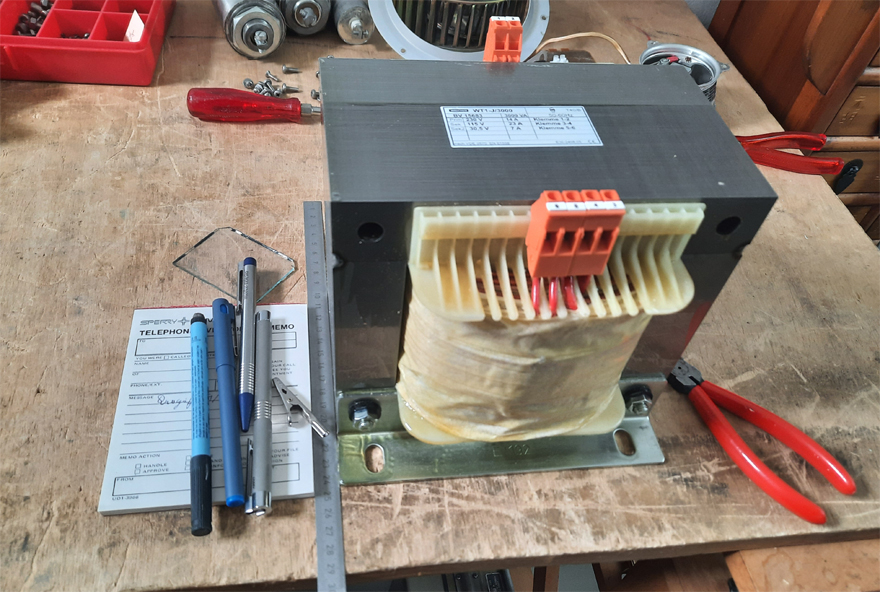
Eigens für den AN/UYK-7 beauftragter Transformator der Firma
WALCHER, 2024.
|
Das Chassis beherbergt neben der Einschaltlogik für die
Elektrik einen Doppellüfter (ROTRON), das fest verdrahtete
Backplane, ein Operator Panel und mit einem I/O-, einem Instruction-
und einem Operand-Bus insgesamt drei Bussysteme zu je 52 verdrillten
Adern. Jede Ader ist an ihren Enden jeweils mit 100 Ohm abgeschlossen
und mit 2,5 Volt vorgespannt - eine vergleichsweise
aufwändige, aber auch sehr resiliente und stabile Architektur.
Mit den Bussystem lassen sich auch je nach Steckplatz die
Prioritäten der einzelnen Module hardware-seitig steuern.
|

SPERRY Univac: AN/UYK-7 computer set cabeling. Ausschnitt unten. USA,
ca. 1974
|
Nach Austausch der 115V-Relais und des -Lüfters, dem Wechsel der
primärseitigen
Signallampen auf 230V Spannungsversorgung im Gestell, sowie die
Ausrichtung
des Gehäuses und des Netzteil-Einschubs auf die einphasige
Sekundärspannung
können die vier "Switching Regulators" im Netzteil in Betrieb
genommen werden. Diese vier Haupt-Schaltnetzteile wandeln die
-150V-Spannung in eine interne -90V-Spannung, die widerum Grundlage
für
die Schaltnetzteile in den einzelnen Rechnermodulen ist.
Elektronisch sind die Schaltnetzteile (von 1968) noch von anderer
Bauweise als heutige (2024) Modelle: Die Eingangspannung wird mithilfe
eines Oszillators und zwei Gegentakt- Leistungstransistoren gepulst
und auf einen Transformator gegeben, sekundärseitig
gleichgerichtet und abschließend gesiebt und stabilisiert.
Ein
Regelkreis bestimmt die Impulsweite der primärseitigen Pulse
und
somit der Stabilität der Spannung bei sich ändernder
Last.
Für damalige Verhältnisse
sind der Wirkungsgrad und die Leistungsfähigkeit von bis zu
800
Watt bei vergleichsweise geringen Ausmaßen beachtlich.
|
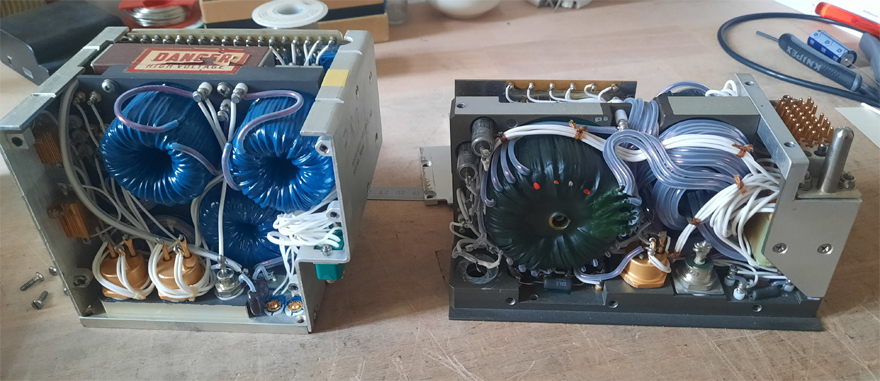
SPERRY Univac: AN/UYK-7 computer set: -90V Schaltnetzteil
(links) und das Netzteil für die CPU. USA, ca. 1974.
|
Jeder der sechs Rechnereinschübe verfügt
über sein
eigenes Netzteil (Bild oben, rechts), das die -90V Spannung
auf bis zu sechs
Arbeitsspannungen (+5V, +15V, +6V ...) wandelt. Die
Ringkertransformatoren sind äußerst
kompakt und
leistungsfähig: in den +5V - Lines fließen insgesamt
bis zu
45A.
|
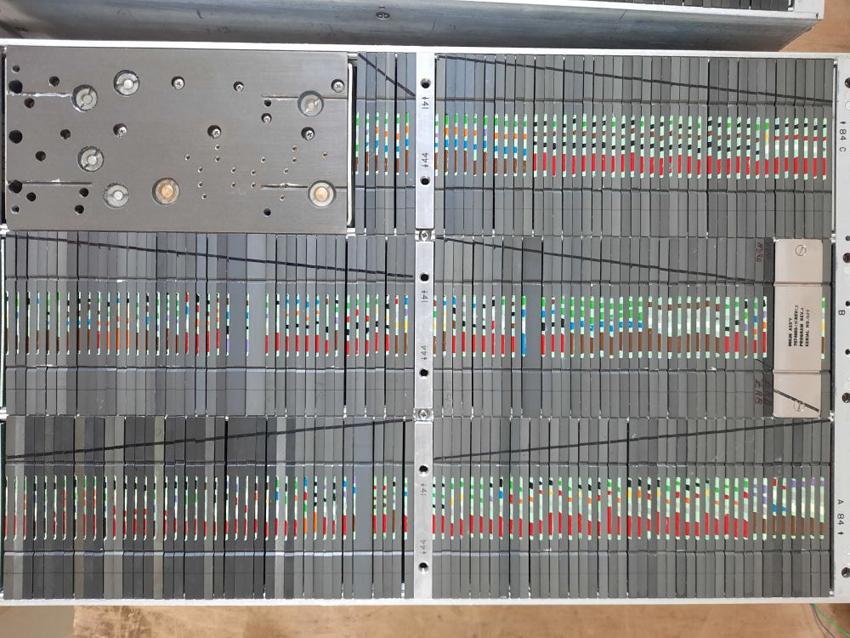
SPERRY Univac: AN/UYK-7 computer set: Central Processor Unit. USA,
ca.1974.
|
Auf dem Bild oben ist die Central Processor Unit bei abgenommenem
Kühldeckel zu sehen. Auf rund 200 Steckkarten ist die gesamte
Logik,
die über 80 Register, die Steuerung und die Arithmetik
untergebracht. Oben links das
CPU-Schaltnetzteil. In der Mitte rechts ist (silbern) das Non
Destructive Readout (NDRO) zu erkennen - ein Fädelspseicher
mit
512 Worten, der neben den Ladeprogrammen auch einige
Prüfroutinen
enthält für CPU, Busse, IO-Controller und den
Speicher
enthält.
|
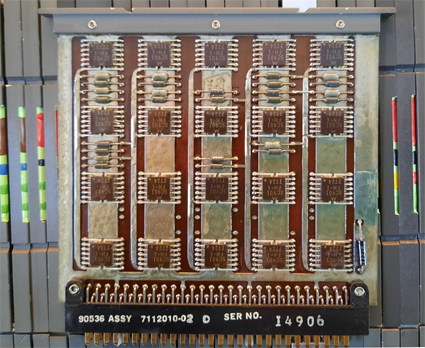
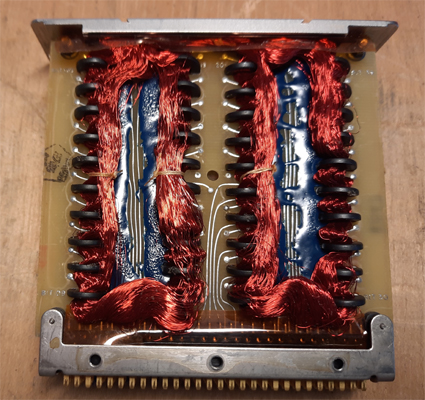
SPERRY Univac: AN/UYK-7 computer set: Baugruppe 2010 (links)
Baugruppe Fädelspeicher NDRO (rechts). USA, 1977.
|
Bild oben zeigt eine typische Steckkarte (Typ 7112010): Ein Teil des
mit
Flip-Flops (MOTOROLA SC901) aufgebauten Arithmetischen Registers. Auf
dem
Bild rechts ist der Fädelspeicher zu erkennen: 512 x 32 Bit
Worte, die in
diesem Falle konkret zwei Ladeprogramme - eines für ein UNIVAC
1840 Bandlaufwerk, das andere für eine Festplatte - und einige
Diagnostik-Routinen persistent hält.
|
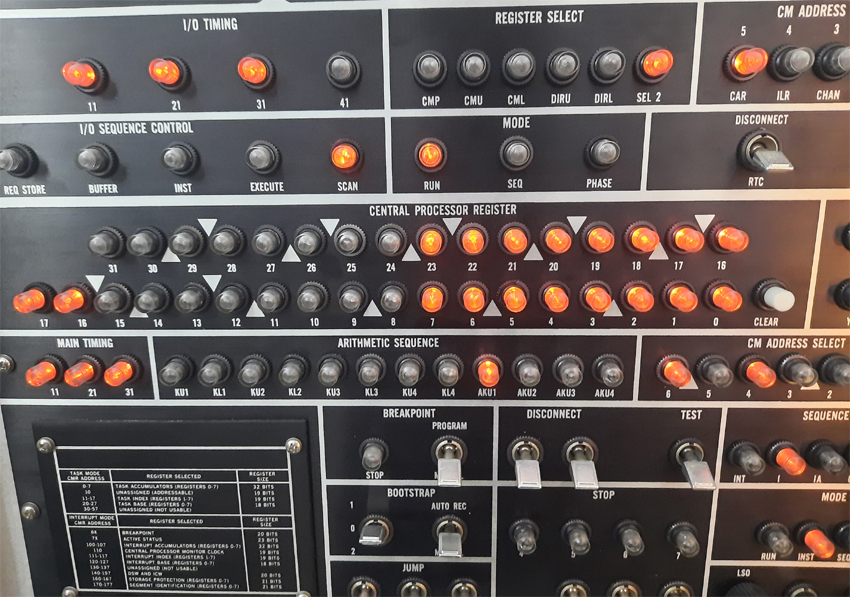
SPERRY Univac: AN/UYK-7 computer set: |
Die auch von ganz frühen UNIVAC-Rechnern bekannte Maintenance
Console mit etlichen Schaltern und Lämpchen ist für
den
AN/UYK-7 computer in obigen Bild
im Ausschnitt abgebildet. An dieser Konsole lassen sich Programme
laden, die Inhalte der Central Memory Register anzeigen und
verändern, der gesamte
Programmablauf steuern, Stoppbedingungen einlegen und
Programmabläufe bis in jede Arithmetische Phase einsehen. Die
Console ist unterteilt in den Teil für den IO-Controller
(oben) und den unteren, größeren Teil für
die Central Processing Unit.
(Angezeigt wird im Bild oben ein aus dem Speicher in das 32-Bit
U-Register eingelesener Test-Patter bestehend aus im Wechsel acht
Nullen und acht Einsen.
Wie "tickt" dieser Rechner ?
Der SPERRY UNIVAC AN/UYK-7 ist gemessen an seinen Zeitgenossen Ende der
1960er, Anfang der 1979er Jahre eine vergleichsweise komplexe,
vielschichtige Maschine. Das mag an seinem Einsatzgebiet als
Marinerechner mit entsprechend anspruchsvollem Lastenheft liegen, aber
auch daran, dass kaum ein anderes Unternehmen eine derart tiefe und
langjährige Erfahrung im Digital-Rechnerbau hatte wie SPERRY
UNIVAC (SPERRY hatte 1955 durch Übernahme von REMINGTON RAND
auch die Computersparte UNIVAC übernommen; UNIVAC setzte sich
u.a. aus einem dem ENIAC-Projekt hervorgegangenen Team
zusammen).
In der mir überlieferten Geschichte gilt der SPERRY UNIVAC
AN/USQ-20 (auch UNIVAC 1206, NTDS oder CP642A) als der
Vorgänger des AN/UYK-7; zumindest waren AN/USQ-20s auch bei
der Bundesmarine im Einsatz und wurden dann durch AN/UYK-7 Rechner
abgelöst. Aus der "SPERRY
UNIVAC COMPUTER GENEALOGY" geht der
CP855 von 1965 (auch unter der Bezeichnung UNIVAC 1230) als technischer
Vorläufer hervor.
Beide 30-Bit Systeme lassen die Konzepte und Begrifflichkeiten des
AN/UYK-7 bereits deutlich erkennen; in mancherlei Hinsicht ist der
AN/UYK-7, was seine Arithmetik und vorallem die zum Einsatz kommende
Halbleiter-Technologie angeht, aber mehr eine Neu- denn nur eine
Weiterentwicklung.
Der AN/UYK-7 ist - allein schon wegen seiner um 2 Bit erweiterete auf
32 Bit Wortbreite - nicht abwärtskompatibel, spricht aber nach
außen hin das gleiche NTDS (Narval Tactical Data System).
Der sehr umfängliche Befehlssatz für den AN/UYK-7
erfordert eine recht ausdifferenzierte Arithmetik mit entsprechend
mehrphasigem Timing.
Die untenstehenden Bilder geben einen Eindruck des Zusammenspiels:
Links:
Die Takte der CPU-MasterClock werden in ein Main-Timing
(Hauptzeitsteuerung) überführt, das den gesamten
Ablauf innerhalb der CPU koordiniert. Aus der Hauptzeitsteuerung geht
auch das Signal "Start Arithmetic" (SA) hervor, das wiederum eine Reihe
weiterer Zeitsteuerimpule (AK-, K- und K*- Zeitsteuerketten)
für die interen Arithmetik initialisiert. Diese
Zeitsteuerketten sind als Ringzähler organisiert, die je nach
Komplexität des auszuführenden Befehls mehr oder
weniger weit durchgetaktet werden. Der Zustand der AK- und
K-Zeitsteuerketten werden auch auf der Maintenance Console zur Anzeige
gebracht, was ein sehr detailiertes Studium des Rechenwerks und der
Ablaufsteuerung bei einezelnen Befehlen ermöglicht.
Rechts:
Mitschnitt des Timings eines Ladebefehls (f=10) mit einem
Logik-Analyzer (HP 1630D), das auch das Zusammenspiel Bussteuerung und
Arithmetik zeigt. Die AKU-Signale sind low-active.
Main Timing 1, Main Timing 2, Main Timing 3,
AK-Timing Upper 1, AK-Timing Upper 2, AK-Timing Upper 3,
AK-Timing Upper 4,
Start Arithmetik,
Initiate AT0-Timing (Start der K-Sequenz),
Late Hold
Operate Clock Hold
Start
|


SPERRY Univac: AN/UYK-7 computer set: Main-Timing (links) und Ablauf
der AK-Timing-Chain (rechts).
|
Untenstehend noch die Theorie des gleichen Befehls (f=10) aus
den Lehrgangs-Unterlagen.
Wer also sehr genau hinschaut erahnt im Vergleich mit dem Bild des
Mitschnitts Logic Analyzer den Fehler, den die reale CPU hatte: Die
AKU-Signale überschneiden sich, dürften es aber
theoretsch nicht. Es hatte am realen Rechner zur Folge, dass
die CPU bei Eintritt in die Arithmetische Sequenz Inhalte von Registern
durcheinanderwürfelte und fehlerhaft gerechnet hat (bis zu
diesem Zeitpunkt - korrekter Speicherzugriff, Befehlsholung,
Einsortieren und Interpretation des Befehls - war alles OK).
Das Problem konnte am Ende nur dadurch gelöst werden, dass dem
AN/UYK-7 ein anderer CPU-Einschub spendiert wurde (Danke
dafür), in der sich ein mit den Lehrgangsunterlagen
identisches Timing volzog :-).
|
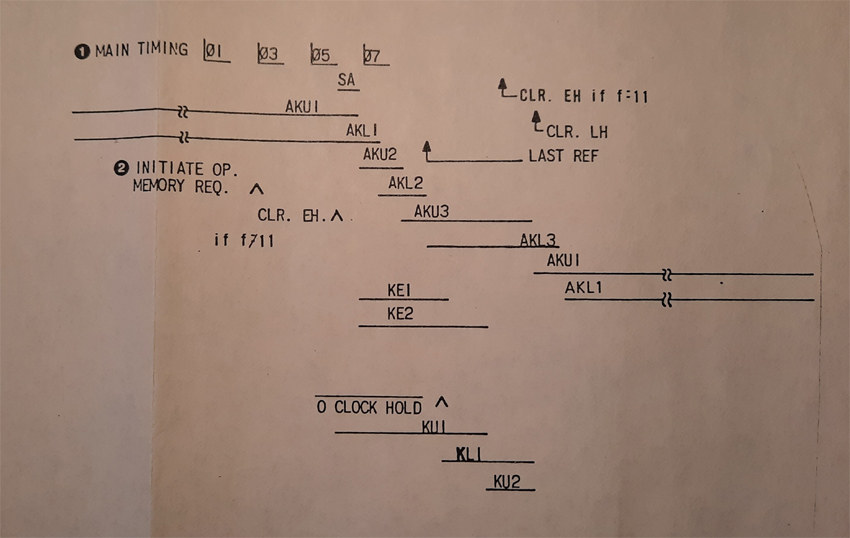
SPERRY Univac: AN/UYK-7 computer set: Zeitdiagramm beim Befehl Lade
Akkumulator A (f=10).
|
Der AN/UYK-7 Computer ist ein Spezialist und entlang den
Anforderungen zum Betrieb auf einem Marineschiff hin konzipiert, was
sich insbesondere am Interrupt-Handling und an seinen sehr
umfangreichen I/O-Schnittstellen (mit eigenem I/O-Controller) zeigt.
Von seinem Befehlssatz her ist der Rechner aber auch ein
großer Universalist (General Purpose Computer), der es
mühelos mit anderen Rechnern aus seiner Zeit und anderen
Aufgabenstellungen aufnehmen kann.
Eine erste Programm- und Software-Studie bieten die im NDRO
hinterlegten Routinen, die nach Setzen eines Bits im Active Status
Register ausgelesen und ausgeführt werden können.
In dem hier verbauten NDRO mit der Endung -135 sind das u.a
Memory Test
location 606 - 653
entrance 607
Interface Test
location 654 - 747
entrance 655
Inspect and Change location 736 - 776
entrance 776
Der AN/UYK-7 kennt 130 Grundbefehle. Aller Anfang ist schwer - das
erste (eigene) Programm schrieb und erklärte mir ein ehemalger
Service-Ingenieur: Eine einfache Schleife die den Zustand eines
Schalters auf der Wartungskonsole abfragt. Das zweite selbst erstellte
Programm kopiert den Inhalt des NDRO in den Doueble Density Film Memory
(DDFM).
Die aus wenigen Zeilen bestehenden Programme lassen sich (Bit
für Bit) über die Management Console eingeben und in
32 BitBlöcken den Speicher übertragen:
|
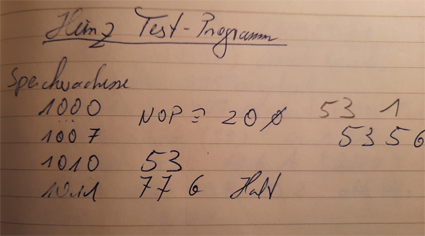

SPERRY Univac: AN/UYK-7 computer set: Zwei (einfache) Programme
|
Was den AN/UYK7 (und Ähnliche) zu einer Ausnahme in der
Rechnerwelt macht ist zum einen seine starke Orientierung an die
Datenein- und -ausgabe. Der Ein-/ Ausgabe - Adapter (IOA) stellt 16
Kanäle zur Verfügung, wobei jeder Kanal über
eine separate Ein- und Ausgabe-Buchse verfügt. Die zweite
Besonderheit: Alle Ein- und Augabekanäle sind auf das
marine-eigene NTDS ausgerichtet - eine (bis heute) in MIL-STD-1397C
beschriebene Schnittstelle (man würde heute sagen: ein
Protokoll).
So leicht verständlich das Format auch ist - diese
Schnittstelle ist mit keiner anderen Computer-Schnittstelle auch nur
annähernd kompatibel (sprich: man kann nichts Bekanntes an den
Rechner anschließen). Es sind weder Übersetzer, noch
Adapter erhätlich oder hinreichend beschrieben.
|

SPERRY Univac: AN/UYK-7 computer set: Ein- /Ausgabe- Adapter
|
Erst etwas später fand sich für den AN/UYK-7 in der
Sammlung ein (zunächst uni-direktionaler)
Gesprächsparter: Ein UNIVAC Type 47209 NTDS Paper Tape Reader.
In einemWartungs-Koffer eingebaut ist ein eher
selten anzutreffender DIGITRONICS 2031 Lochstreifenleser untergebracht,
der innen und auf der Rückseite von UNIVAC um eine
NTDS-Schnittstelle ergänzt wurde.
|
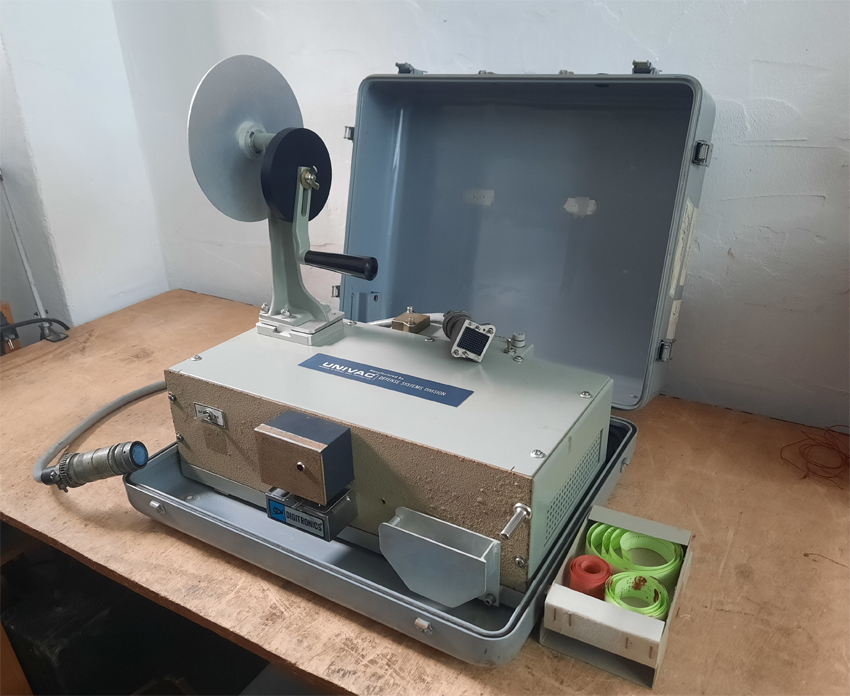
SPERRY Univac: AN/UYK-7 computer set: UNIVAC Type 47209 Paper Tape
Reader
|
Nach der erfolgreichen Instandsetzung des UNIVAC 47209 (zum
Glück
war die Dokumentation inliegend) musste noch ein
Überspielkabel
angefertigt und ein kleines Ladeprogramm geschrieben werden.
Das erfolgreiche Einspielen eines beiliegenden Lochstreifens mit
Muster-Pattern lässt sich in diesem
Video bestaunen (mp4-Format).
Literatur/
Dokumentation
NAVSEA 0967-LP-319-4010 Technical
Manual, Volume 1, Sections 1-5, Operation & Maintenance. SPERRY
UNIVAC, September 1977.
NAVSEA 0967-LP-319-4020 Technical Manual, Volume 2, Section 6, Parts
List. SPERRY UNIVAC, September 1977.
NAVSEA 0967-LP-319-4030 Technical Manual, Volume 3, Circuit Diagram
Manual, Part 1. SPERRY UNIVAC, September 1977.
NAVSEA 0967-LP-319-4040 Technical Manual, Volume 4, Circuit Diagram
Manual, Part 2. SPERRY UNIVAC, September 1977.
PX 6503 NDRO Program Operating Procedures. SPERRY UNIVAC, September
1973.
PX 5652E AN/UYK-7 Technical description. SPERRY UNIVAC, 1972
Test
PROGRAM
NAVSEA 0967 LP-024-5474 Part II
Supplemetary Diagnostic Test Program (paper tape)
|
| |
|
| |
| |
| Kategorien |
Computersysteme
<--
-->
|
|
